Semolina Bread is one of the breads we made for the Mellow Bakers group this month. I like Semolina Bread especially Pane Siciliano so I was all over this one. I had the dough made and the loaves shaped and placed in the refrigerator overnight to retard.
Then, I went to the Mellow Bakers’ forum to read what the other bakers had to say about the bread and realized I had made the wrong bread. I was supposed to make Semolina Bread with a soaker and fennel seed. Oops! I guess I’ll just have to make it again. <big smile>
In the meantime, I’ll enjoy this one.
I really enjoyed the BBA Pane Siciliano so when I saw that the formulas were similar, I decided to shape and bake the Mellow Bakers’ Semolina Bread the same way we did the BBA Pane Siciliano.
The main difference is that the BBA version utilizes a Pate Fermentee of bread flour and all-purpose flour; whereas Hamelman’s version uses a sponge made with semolina (durum flour) and bread flour. The BBA version consists of 40 percent semolina flour and 60 percent high-gluten or bread flour. Hamelman’s version consists of 50% semolina flour and 50% bread flour.
Semolina Bread (Pane Siciliano)
Adapted from Bread: A Baker’s Book of Techniques and Recipes by Jeffrey Hamelman and the Bread Baker’s Apprentice by Peter Reinhart
Makes: 3 loaves
Ingredients:
Sponge:
- 1 1/2 cups (6.4 oz.) Semolina flour
- 1 1/2 cups (6.4 oz.) Bread flour
- 1 1/8 cups (9 oz.) lukewarm water (90 degrees to 100 degrees F) (I used 1 1/2 cups)
- 1 1/4 teaspoons (.13 oz.) instant yeast
- 1/2 teaspoon (.06 oz.) sugar
Final Dough:
- 2 1/8 (9.6 oz.) cups Semolina flour
- 2 1/8 (9.6 oz.) cups Bread flour
- 1 cup (8.3 oz.) water, more if needed (I used ~1 1/2 cups)
- 1 tablespoon (.6 oz.) salt
- 3 tablespoons (1.6 oz.) olive oil
- All of the sponge
Directions:
Sponge:
Mix the semolina flour, bread flour, water, yeast, and sugar in the mixer until evenly incorporated. The sponge should be fairly loose. My sponge wasn’t loose so I added more water. I ended up using about 1 1/2 cups of water rather than the 1 1/8 cups the original formula suggested.
The sponge ripens in a short time so you need to use warm water to bring the temperature to 78 to 80 degrees F. Let the sponge ripen for 1 1/4 hours. It should be on the verge of collapse at this point.
Mix all of the ingredients, including the sponge in a stand mixer until all of the ingredients have been incorporated. The dough should be of medium consistency, with good dough strength and gluten development. Cover the dough with plastic wrap and let it ferment for 1 1/2 hours.
Fold the dough after 45 minutes of bulk fermentation.
Gently divide the dough into 1.5-pound pieces. Shape as for baguettes. To do this, you first shape them into batards.
Gently pat the dough into a rectangle. Without degassing the piece of dough, fold the bottom third of dough, letter style, up to the center and press to seal, creating surface tension on the outer edge. Fold the remaining dough over the top and use the edge of your hand to seal the seam closed and to increase the surface tension all over.
Set the batards aside to rest for further shaping.
Working from the center of the loaf and moving to the outside edges, gently but firmly rock and roll out the dough to extend each piece to about 24 inches in length taking care to degas the dough as little as possible. Working from each end simultaneously, coil the dough toward the center, forming an S shape.
Line a sheet pan with baking parchment and sprinkle some semolina flour on the baking parchment. Place each loaf on the pan. Mist the loaves with water and sprinkle sesame seeds on the top of each loaf. Then mist the tops with vegetable spray oil and place the pans in a food-grade plastic bag or loosely cover with plastic wrap.
Place the pans in the refrigerator overnight.
The next day, remove the pans from the refrigerator and let them warm up to room temperature. It was really cold in my house so this part took awhile. I got busy doing other things so I let them proof a bit too much. They were huge!
Prepare the oven for hearth baking by placing a baking stone on the middle rack and a steam pan underneath. Preheat the oven to 500 degrees F. You actually don’t need to bake this bread on the baking stone, you can bake it on the baking sheet with just the steam pan underneath if you prefer. I usually bake this bread that way, but this time, I opted to bake it on the stone.
After you place the loaves in the oven, pour 1 cup hot water into the steam pan and close the door. After 30 seconds, spray the oven walls with water and close the door. Repeat twice more at 30-second intervals. After the final spray, lower the oven setting to 450 degrees F and bake for about 15 minutes. If the loaves are touching, gently separate them.
Rotate the pan(s) 180 degrees for even baking and continue baking for 10 to 15 minutes more, or until the loaves are a rich golden brown all over. If there are still light or white sections of the dough, extend the baking time for a few extra minutes to maximize color and flavor.
Remove the pan from the oven and transfer the loaves to a cooling rack. Cool for at least 45 minutes before serving.
This bread has a delicious, toasty flavor due to the sesame seeds. It’s really good! I like this 50/50 version but I also like the BBA 40/60 version. Not sure which one I like better. My taste tester couldn’t decide either. He just said this one tastes delicious! I agree.

Mellow Bakers was hosted by Paul at Yumarama. We baked breads from Bread: A Baker’s Book of Techniques and Recipes by Jeffrey Hamelman.
Happy Baking!
Cathy
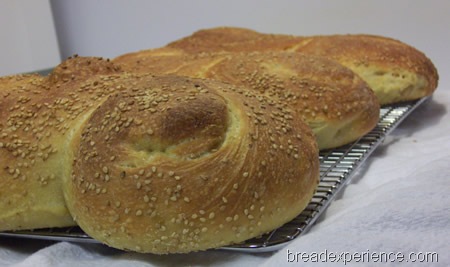
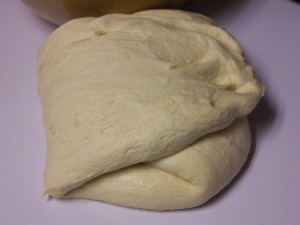
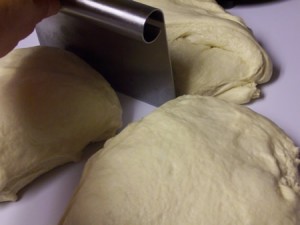
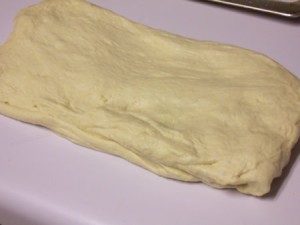
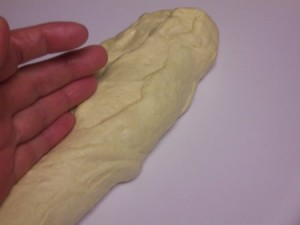
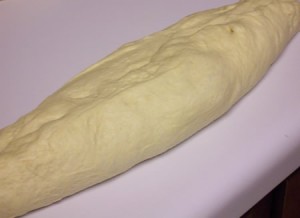
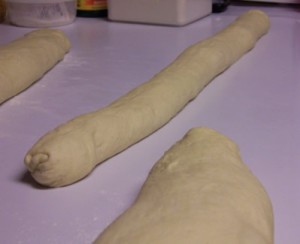
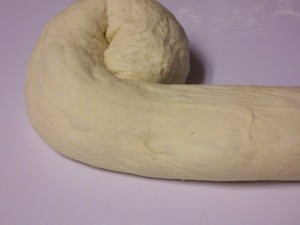
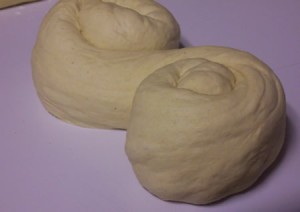
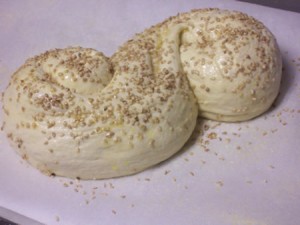
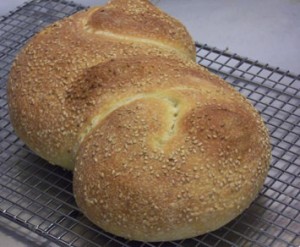
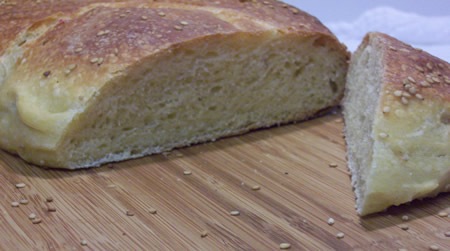
Joanna @ Zeb Bakes says
I love the shape of this bread Cathy! Can’t wait to make this one too. Just went on a hunt for the ingredients for the one with the soaker, could I find wheat flakes? No, I bought a bag of spelt flakes and hope they will do….
Cathy (breadexperience) says
Hi Joanna, I love the shape of this bread as well. I haven’t been able to find wheat flakes either. Good idea to use Spelt flakes. I bet that will be good.
drfugawe says
Hi Cathy,
I’m having some confusion about what they call Semolina flour here in the US – I got some “semolina flour” at a bulk grocery, thinking I’d make some bread and pasta with it – but my initial experiences have been disappointing – my pasta was gritty and it didn’t have much gluten development – it sure wasn’t “fine” in any way. Is this the kind of semolina flour you can buy in GA? I’m in Oregon.
Joanna has given me a few tips, but in the UK they have different kinds of flour that we do.
Cathy (breadexperience) says
Hi Doc. The Semolina flour I used is from the Farmer’s market. It is similar to Bob’s Red Mill Semolina flour which I’m able to get in the grocery stores in Georgia. It is very fine.
I’ve made several breads using Semolina flour but I always use a high percentage of bread flour or all-purpose. I’ve also used it in pizza. Semolina flour adds a great flavor and texture to breads but you do have to use mostly all-purpose or bread flour or it won’t rise. Haven’t tried to make pasta yet so not sure how it performs for that.
Rob says
Dear Cathy
There seems to be a weight mistake in this récipe
1/2 teaspoon (.6 oz) sugar
1 tablespoon (.6 oz) salt
thank you
Rob
Cathy W. says
Hi Rob, thank you for bringing this to my attention. The formula in the book “Bread” gives these weights, however, that is not correct. 1/2 teaspoon should be .06 oz sugar and the .6 oz (1 T) of salt is correct. I updated the post to .06 oz sugar although you could use more. I’ve also seen this type of bread with no sugar added or even 1 T of honey. Hope this helps. Sorry for the confusion.
MarySC says
Semolina flour does NOT weigh the same as bread flour.
One cup of semolina weighs 180g, so there should be 270g in the sponge and 375g in the final dough.
(I discovered this while trying to figure out why my final dough was soup.)
Cathy says
Hi Mary,
Both books list the same weight for both types of flour. It’s possible the semolina flour you used weighs more. However, after reviewing the water amounts listed in the sponge and final dough, they appear to be a bit too high. This might be why your dough was soupy. I have edited the amount of water listed in the formula.
MarySC says
Thanks for the reply. The bread was absolutely delicious with a great crust and superb crumb. I see that Reinhart’ BBA recipe does list the same weight for both flours. I used Bobs Red Mill semolina and took the flour weight straight from the package (¼ c= 45 g).
The proportions would be very different using volume and weight and I’m not sure which is “right”. In my case of course I just dumped in more semolina until I got a medium dough.
I think Reinhart does weigh his flour so I am perplexed! 🙂
Cathy says
Thank you for sharing your experience with this bread. I’m glad it turned out well and tasted good.
I tend to go with the weight measurements because the sizes of measuring cups can vary, and it’s easier to weigh the ingredients. Adding more flour during mixing is sometimes necessary (as you know), but holding back some of the water first might be helpful.
MarySC says
I discussed this with Peter Reinhart (such a nice guy!). He says the semolina weight is not correct. More semolina flour (by weight) is required to achieve the 40% semolina/60% bread flour ratio.
He is planning to make a correction in the next edition of BBA.
Of course his original recipe is quite different from yours; I’ve checked my math and I believe the weights I gave previously are correct for this recipe.
Cathy says
Thanks for the info. That’s good to know.
Jean Pearce says
This request involves an older thread, but I hope you can answer my question. It pertains to the recipe for Pane Siciliano in the Bread Bakers Apprentice. I have made it in earlier years using the volume measurements and it was very good. “exc” was my notation. I have just pruchased a scale and used the “weights”. When I measured 8 oz of each of the flours, it came out as 1 1/4 cup, not 1 3/4 cup. I checked it against a commercial scale I have and the new scale was correct. That is a difference of 1 C flour. I was not sure which was wrong, the volume requirement or the weight. Or have I made a mistake. I hope you can help me with this. Thank you in advance, Jean Pearce, Hartfield, Va.
Cathy says
I assume you are referring to the bread in this post https://www.breadexperience.com/bba-pane-siciliano/.
Response edited 1/13/2021.
When I originally made the Pane Siciliano from the BBA book, I used volume measurements. At the time I went through the challenge and made all of the breads from the book, I hadn’t embraced baker’s percentages and weight measurements yet. I have now. So I have added the weight measurements to the post.
According to this online calculator https://www.traditionaloven.com/conversions_of_measures/flour_volume_weight.html, 8 ounces of US all-purpose flour and 8 ounces of US bread flour equals 1 3/4 cup flour.
Measuring cups can vary. All 4 of my measuring cup sets are different weights. So that could be the issue. Apparently, the semolina weight is off in the book, but I think the regular flour weight is okay.